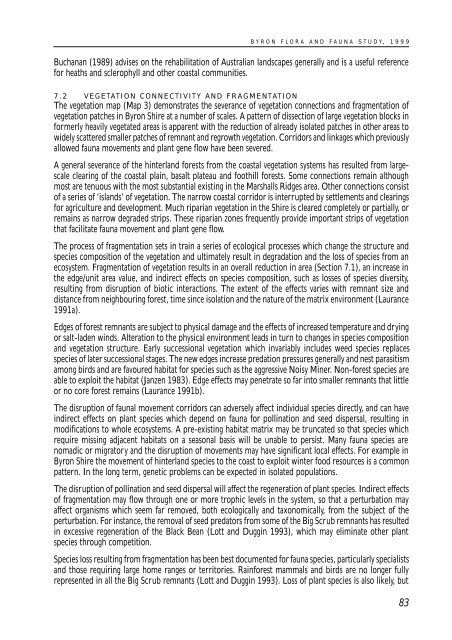Byron Flora and Fauna Study 1999 - Byron Shire Council
Byron Flora and Fauna Study 1999 - Byron Shire Council
Byron Flora and Fauna Study 1999 - Byron Shire Council
Create successful ePaper yourself
Turn your PDF publications into a flip-book with our unique Google optimized e-Paper software.
BYRON FLORA AND FAUNA STUDY, <strong>1999</strong><br />
Buchanan (1989) advises on the rehabilitation of Australian l<strong>and</strong>scapes generally <strong>and</strong> is a useful reference<br />
for heaths <strong>and</strong> sclerophyll <strong>and</strong> other coastal communities.<br />
7.2 VEGETATION CONNECTIVITY AND FRAGMENTATION<br />
The vegetation map (Map 3) demonstrates the severance of vegetation connections <strong>and</strong> fragmentation of<br />
vegetation patches in <strong>Byron</strong> <strong>Shire</strong> at a number of scales. A pattern of dissection of large vegetation blocks in<br />
formerly heavily vegetated areas is apparent with the reduction of already isolated patches in other areas to<br />
widely scattered smaller patches of remnant <strong>and</strong> regrowth vegetation. Corridors <strong>and</strong> linkages which previously<br />
allowed fauna movements <strong>and</strong> plant gene flow have been severed.<br />
A general severance of the hinterl<strong>and</strong> forests from the coastal vegetation systems has resulted from largescale<br />
clearing of the coastal plain, basalt plateau <strong>and</strong> foothill forests. Some connections remain although<br />
most are tenuous with the most substantial existing in the Marshalls Ridges area. Other connections consist<br />
of a series of ‘isl<strong>and</strong>s’ of vegetation. The narrow coastal corridor is interrupted by settlements <strong>and</strong> clearings<br />
for agriculture <strong>and</strong> development. Much riparian vegetation in the <strong>Shire</strong> is cleared completely or partially, or<br />
remains as narrow degraded strips. These riparian zones frequently provide important strips of vegetation<br />
that facilitate fauna movement <strong>and</strong> plant gene flow.<br />
The process of fragmentation sets in train a series of ecological processes which change the structure <strong>and</strong><br />
species composition of the vegetation <strong>and</strong> ultimately result in degradation <strong>and</strong> the loss of species from an<br />
ecosystem. Fragmentation of vegetation results in an overall reduction in area (Section 7.1), an increase in<br />
the edge/unit area value, <strong>and</strong> indirect effects on species composition, such as losses of species diversity,<br />
resulting from disruption of biotic interactions. The extent of the effects varies with remnant size <strong>and</strong><br />
distance from neighbouring forest, time since isolation <strong>and</strong> the nature of the matrix environment (Laurance<br />
1991a).<br />
Edges of forest remnants are subject to physical damage <strong>and</strong> the effects of increased temperature <strong>and</strong> drying<br />
or salt-laden winds. Alteration to the physical environment leads in turn to changes in species composition<br />
<strong>and</strong> vegetation structure. Early successional vegetation which invariably includes weed species replaces<br />
species of later successional stages. The new edges increase predation pressures generally <strong>and</strong> nest parasitism<br />
among birds <strong>and</strong> are favoured habitat for species such as the aggressive Noisy Miner. Non-forest species are<br />
able to exploit the habitat (Janzen 1983). Edge effects may penetrate so far into smaller remnants that little<br />
or no core forest remains (Laurance 1991b).<br />
The disruption of faunal movement corridors can adversely affect individual species directly, <strong>and</strong> can have<br />
indirect effects on plant species which depend on fauna for pollination <strong>and</strong> seed dispersal, resulting in<br />
modifications to whole ecosystems. A pre-existing habitat matrix may be truncated so that species which<br />
require missing adjacent habitats on a seasonal basis will be unable to persist. Many fauna species are<br />
nomadic or migratory <strong>and</strong> the disruption of movements may have significant local effects. For example in<br />
<strong>Byron</strong> <strong>Shire</strong> the movement of hinterl<strong>and</strong> species to the coast to exploit winter food resources is a common<br />
pattern. In the long term, genetic problems can be expected in isolated populations.<br />
The disruption of pollination <strong>and</strong> seed dispersal will affect the regeneration of plant species. Indirect effects<br />
of fragmentation may flow through one or more trophic levels in the system, so that a perturbation may<br />
affect organisms which seem far removed, both ecologically <strong>and</strong> taxonomically, from the subject of the<br />
perturbation. For instance, the removal of seed predators from some of the Big Scrub remnants has resulted<br />
in excessive regeneration of the Black Bean (Lott <strong>and</strong> Duggin 1993), which may eliminate other plant<br />
species through competition.<br />
Species loss resulting from fragmentation has been best documented for fauna species, particularly specialists<br />
<strong>and</strong> those requiring large home ranges or territories. Rainforest mammals <strong>and</strong> birds are no longer fully<br />
represented in all the Big Scrub remnants (Lott <strong>and</strong> Duggin 1993). Loss of plant species is also likely, but<br />
83

















